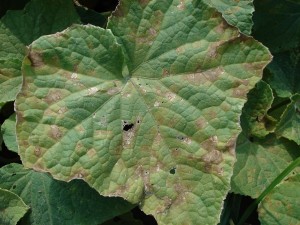Basil downy mildew
Basil Downy Mildew remains active in New Jersey. All basil growers should scout on a daily basis and taking appropriate preventative measures.
Cucurbit downy mildew
Cucurbit Downy Mildew has been reported as far north as northern Maryland and in central Michigan to-date. With the latest weather this past week, all cucurbit growers should scout on a regular basis and adjust fungicide programs accordingly and begin to apply downy mildew specific fungicides if not already done so. Organic growers should apply copper or other OMRI-approved products to help prevent and suppress downy mildew development. If you suspect CDM on your farm please contact your count agent so we can confirm and report it. To track downy mildew in the US please visit NCSU’s Downy Mildew Forecasting Website.
Cucurbit growers should scout on a regular basis and adjust fungicide programs to incorporate powdery mildew specific fungicides into their weekly fungicide programs.
Peppers and Tomatoes
Bacterial leaf spot has been reported on both crops. Heavy wind and rains have been experienced throughout the state. Remember that all bacteria need a natural opening (i.e., stomata) or a wound (i.e., from typing or pruning) to enter a plant to start an infection.
[Read more…]

